Eagle Transporter
Origins
Brian Johnson designed the Eagle in 1973, inspired by real world spacecraft and other vehicles, and the fictional vehicles he had worked on in 2001: A Space Odyssey and Thunderbirds. Here are some of the primary sources that influenced the design.
The direct ancestor of the Eagle was the moonbus from 2001: A Space Odyssey. The moonbus was designed by Harry Lange and Frank Ordway with film designer Tony Masters. The model was built by Mastermodels (original model photos), the first model built for the film. The model was detailed by Doug Trumbull and Brian Johnson: "When Doug Trumbull and I were working on it, way back in '64, '65, I decided that it should look nicer if we had bits of plastic kit and girdering stuff all over it. But I hadn't designed it, that was somebody else's job. So I just mentally made a few notes, and sketched something. It actually had big round pods on the side, not the octagonal jobs. " 2014 comments. Most of the shots of the moonbus in the film were still photographs, shot by Brian Johnson, and combined with stars and moonscapes on an animation stand.
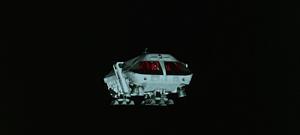

The Eagle takes from the Moonbus the basic rectangular shape with complex angles, large feet pads, and the inset windows with black ledges. The side windows of the Moonbus probably inspired the Eagle passenger module windows, although they never appeared as windows in the series.
After the Moonbus, the strongest influence on the design of the Eagle was probably real NASA spacecraft, particularly the Apollo missions. Real spacecraft were modular, separating into different configurations for specific mission phases. As such they were a mix of curved surfaces (exposed to atmospheric launch and re-entry), angular facets (operating purely in space) and complex detailing (reaction control systems for manoeuvring, antennae, component hatches).
Like Apollo, the Eagle had a cone shaped command module (presumably suitable for re-entry, although in the series the entire ship can fly in the atmosphere). The distinctive "quad" Reaction Control System (RCS) on the sides of the service module are also on the leg pods of the Eagle. The service module also has a single large service propulsion system (SPS) rocket nozzle to take Apollo from the Earth to the Moon; the Eagle has four nozzles, with the engine propulsion tanks exposed (with elements from the Saturn V F-1 engines). The angular body of the Eagle and leg pods seems inspired by the Apollo Lunar Module (LM) that landed on the Moon. The legs and footpads of the Apollo LM are also reflected in the Eagle, Swift and Superswift.
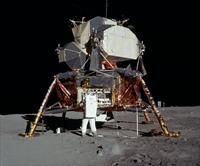
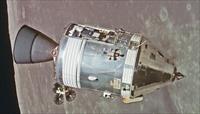
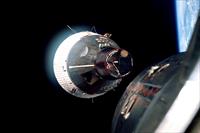
The original concept of Space: 1999 included a "moon hopper". The "Menace In Space" concept has both "moon-hoppers" and "hover hoppers" which are computer controlled VTOL craft, as well as "interceptors" and "moonships", the last of which will become first the "MTU" (modular transport unit), and finally the "Eagle".
These concepts were developed from the previous series UFO; Space 1999 was originally developed as an revamped second series. The Moonhopper in UFO (later called the "moon mobile") was designed by Mike Trim, and travelled low over the lunar surface. The design is insect like, modular, with curves and angular sections, framework sections with permanently extended legs, and inset-front windows with black frames. All these are also features of the Eagle. Brian Johnson did not work on UFO, but he inherited these UFO:2 designs when he started work on Space: 1999. The moonhoppers and moonship would have to look like related technology, although the moonhoppers would eventually be dropped from the series concept when their function was replaced by the moonship/Eagle.
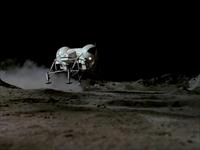
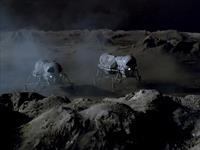
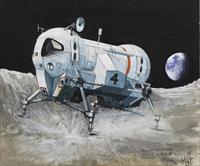
While some aspects of the UFO moon-mobile are influenced by NASA's Lunar Module and the 2001 Moonbus, it was mainly redeveloped from an earlier Gerry and Sylvia Anderson series, Captain Scarlet. In two episodes, "Lunarville 7" and "Crater 101", the original moon-hopper appears, bouncing across the moon surface with bending legs like an insect.
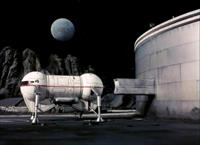
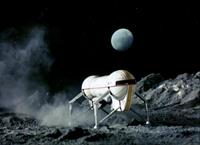
The Rolls-Royce Thrust Measuring Rig (TMR) was a test vehicle used in the early development of vertical take-off; it was the first jet-lift aircraft to fly. It had no wings or propellers, just two vertical jet engines to lift it up, and four arms with compressed air to control orientation. It first flew in 1953 with tests until 1957. The rectangular tubular framework was widely known in the UK as the "flying bedstead". The original vehicle is on display in the London Science Museum.
The Bell Lunar Landing Research Vehicle (LLRV) was a similar vehicle, with a single vertical jet engine mounted on a gimbal, in the US. It was used for training Apollo astronauts, and flew from 1964 to 1972.
The framework design of these vehicles probably inspired the framework of the Eagles.
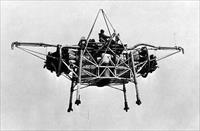
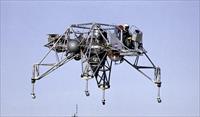
Immediately before 2001, Brian Johnson had been second unit director on Gerry and Sylvia Anderson's series Thunderbirds. Thunderbird 2 was designed by Derek Meddings and also built by Mastermodels (original photos). It is influenced by the real-life Sikorsky S-64 "skycrane" helicopter, which entered service in 1962 and is still manufactured (by Erickson).
Thunderbird 2 can swap different pods, carrying different equipment. The Eagles take this concept and extend it, with different pods.

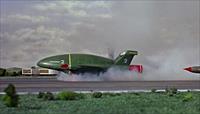
On the box endorsement of the Round 2 22inch Eagle display model (2018), Brian Johnson states "The distinctive tubular framework was used as I liked the Maserati Tipo 61 space frame concept."
The Tipo 61 was better known as the "birdcage". The racing car was designed by Giulio Alfieri in 1958 and driven by Stirling Moss. The other birdcage models were the Tipo 60, Tipo 63, 64 and 65 (with a Birdcage 75th concept car in 2005). While most racing cars were built with steel skeletons, the Tipo was built with a lattice of small steel tubing in geometric forms, making it lighter but strong.

The NASA Lunar Module is quite insect-like in appearance, with the modular shape reflecting the segmented body of insects, plus antennae. The insect-like design directly inspired the Captain Scarlet Moonhopper (which bounced across the lunar surface like an insect) and later the UFO moon-mobile.
In TV Sci-Fi Monthly #3 (April 1976), Johnson described the Eagle as being directly inspired by insects: "I find that if you make spacecraft, and so on, rather insect-like then you are half way there. That seems to be the way our technology is going. Take Concorde as an example. The Eagle was based on a kind of grass-hopper shape which just sort of grew. It was considerably shorter before we started filming, but later it elongated"
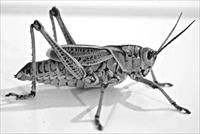
Contents copyright Martin Willey